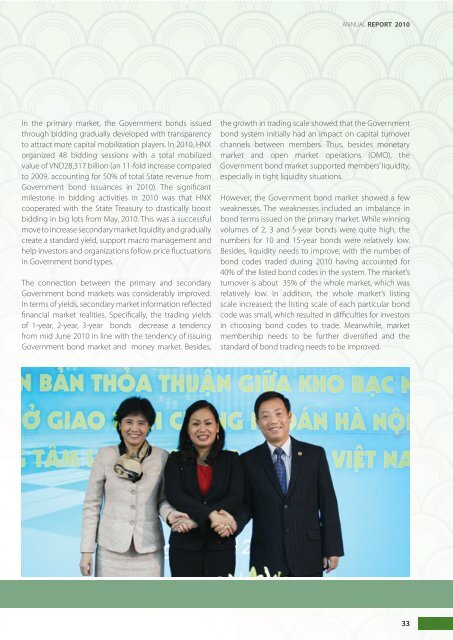hnx snapshot
hnx snapshot
hnx snapshot
- No tags were found...
You also want an ePaper? Increase the reach of your titles
YUMPU automatically turns print PDFs into web optimized ePapers that Google loves.
ANNUAL REPORT 2010In the primary market, the Government bonds issuedthrough bidding gradually developed with transparencyto attract more capital mobilization players. In 2010, HNXorganized 48 bidding sessions with a total mobilizedvalue of VND28,317 billion (an 11-fold increase comparedto 2009, accounting for 50% of total State revenue fromGovernment bond issuances in 2010). The significantmilestone in bidding activities in 2010 was that HNXcooperated with the State Treasury to drastically boostbidding in big lots from May, 2010. This was a successfulmove to increase secondary market liquidity and graduallycreate a standard yield, support macro management andhelp investors and organizations follow price fluctuationsin Government bond types.The connection between the primary and secondaryGovernment bond markets was considerably improved.In terms of yields, secondary market information reflectedfinancial market realities. Specifically, the trading yieldsof 1-year, 2-year, 3-year bonds decrease a tendencyfrom mid June 2010 in line with the tendency of issuingGovernment bond market and money market. Besides,the growth in trading scale showed that the Governmentbond system initially had an impact on capital turnoverchannels between members. Thus, besides monetarymarket and open market operations (OMO), theGovernment bond market supported members’ liquidity,especially in tight liquidity situations.However, the Government bond market showed a fewweaknesses. The weaknesses included an imbalance inbond terms issued on the primary market. While winningvolumes of 2, 3 and 5-year bonds were quite high, thenumbers for 10 and 15-year bonds were relatively low.Besides, liquidity needs to improve, with the number ofbond codes traded during 2010 having accounted for40% of the listed bond codes in the system. The market’sturnover is about 35% of the whole market, which wasrelatively low. In addition, the whole market’s listingscale increased; the listing scale of each particular bondcode was small, which resulted in difficulties for investorsin choosing bond codes to trade. Meanwhile, marketmembership needs to be further diversified and thestandard of bond trading needs to be improved.33







